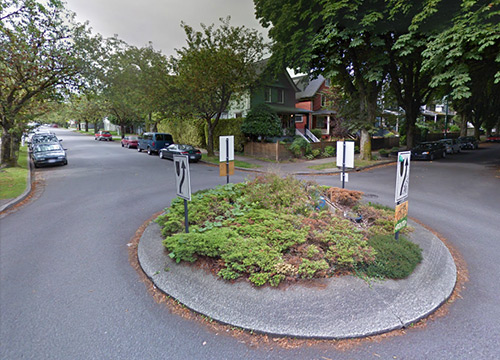
Gather Round Roundabout at St George St at East 10th Ave. Image from Google Streetview.
A few years ago I wrote about a Mark Lakeman event, which I did not attend, so my interest was piqued when a friend of mine mentioned an upcoming event with Lakeman’s name on it.
“Cracks in the pavement: Placemaking and the remaking of the modern city with Mark Lakeman” (tickets still available at Eventbrite) will be Lakeman’s public talk this Friday evening “on Placemaking and Redesigning The Commons” ahead of a 9-month course on the subject.
Placemaking, the creative reclamation of public space was the brainchild of Mark, an urban designer, and his neighbours in 1996 when they transformed their own intersection into a place for community gatherings and interaction — starting a mini revolution in Portland, OR that has spread throughout the city and inspired the creation of City Repair, an organization that engages citzens in transforming places. (Read more.)
Continue reading What is placemaking anyway? »
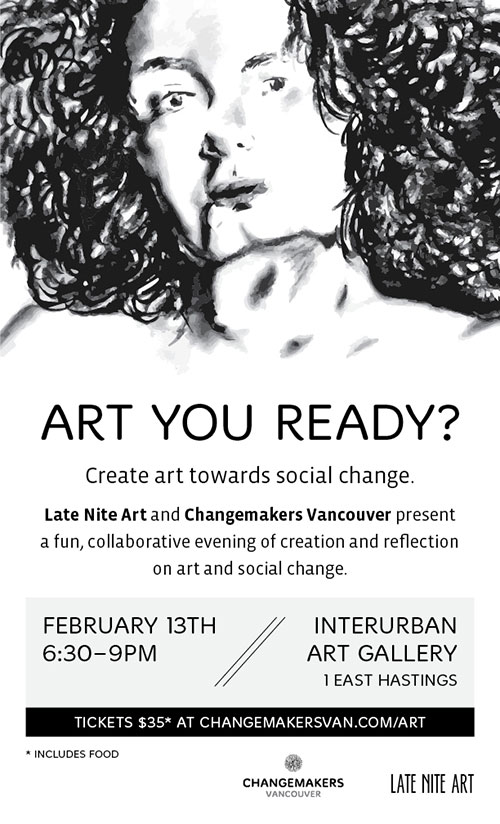
I volunteer my time and design skills to an awesome burgeoning group called Changemakers Vancouver, which is “a network of people who want to learn, share, and act so to make the world a better place.” On February 13th, we’re teaming up with Late Nite Art for an evening around what insights we can gain when we engage our creativity.
Late Nite Art is a facilitated workshop that brings community together to collaboratively explore thought-provoking ideas and issues through visual arts. We achieve this by combining fresh local food, gratuitous beats, and explorative artmaking in one tasty package.
You definitely don’t have to be artistic to participate. In fact, I think the more diverse a crowd we have, the more interesting and fun our evening and outcomes will be!
Really good food is included in your $35 ticket, which you should get today since capacity is limited.
See you there!
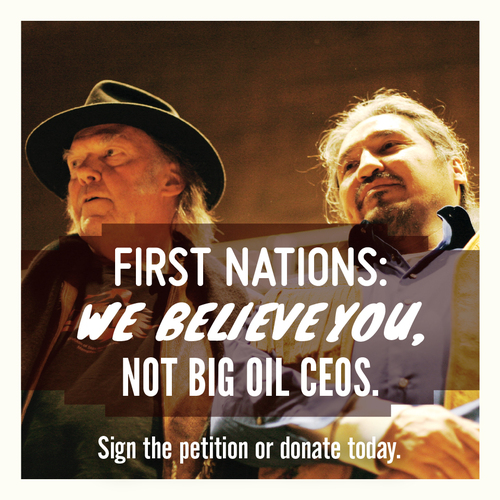
I’ve been driven for at least six years by a desire to make a positive impact on my community and the world. It’s a major reason I worked for the David Suzuki Foundation (and loved it), and a factor in my decision to start my own business. It wasn’t a career choice I’d ever seriously considered for a number of reasons. But I reached a point where my need to affect change, help organisations I’m excited about, and use all my professional skills outweighed some obvious downsides of going solo. (Yes, I do miss having a team.)
Gratefully, it turns out I quite like it.
Here are a few highlights from my first year (well, almost), which includes volunteer work. (Because why not?)
Continue reading Making an impact: my first year in business »
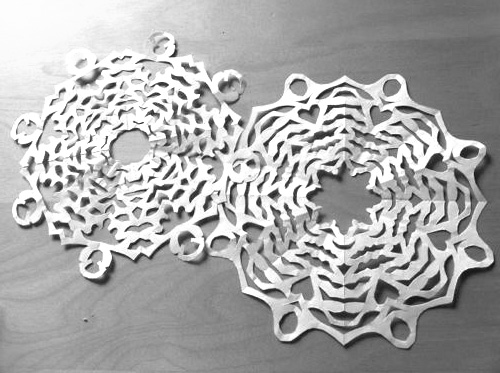
My godsister showed us how to make a perfect snowflake over twenty years ago. Below are easy steps to fold and cut a beautiful snowflake, and tips on making it intricate.
Supplies you’ll need:
- Light-weight white unlined, acid-free paper* (I’ve been using old paper from school)
- Good, sharp scissors that are comfortable to hold
- Weights such as a couple heavy books
- White putty to hang snowflakes
- Your imagination!
* Paper that’s not acid-free will yellow over time. You don’t want that!
Make sure your folding is as accurate as possible on edges, and press down your folded edges.
Continue reading How to make a perfect paper snowflake »
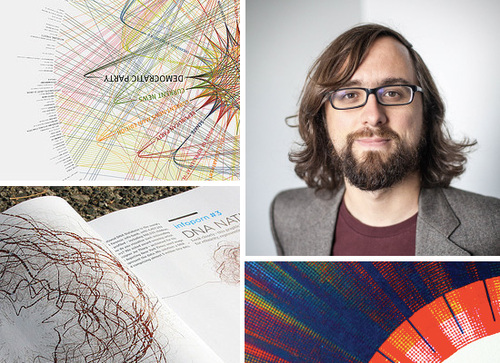
PRACTIVISM 6
Friday, November 29th, 2013
6pm – 10pm at The Ironworks
If you’ve attended any of the previous Practivism speaker events, you probably don’t need convincing to attend this one. Now in its sixth year, the annual event brings change-making creatives from Vancouver and beyond to talk about their projects and the designer’s role in influencing change, whether it be social, environmental or in our practice. This year the keynote speaker is artist and educator Jer Thorp. “Coming from a background in genetics, his digital art practice explores the many-folded boundaries between science, data, art, and culture.”
Our 6th annual Practivism event will explore the opportunities that lay in front of each of us within the vast amount of data we pass by on a daily basis. A panel discussion with Alex Beim, Casey Hrynkow, and Eric Karjaluoto, moderated by Amanda Gibbs will further explore the possibilities and challenge individuals to take action — to envision and mobilize a better future.
The event has grown a lot since its sustainability-focussed beginnings. I’m looking forward to seeing what Thorp offers the event and audience on November 29th.
Get your tickets online now. Practivism sold out last year!
See you there.

I usually spend November 16th with my youngest niece for her birthday — she’s turning eight. But this year, I’ll be standing up for her future at what I hope will be the biggest national rally Canada has ever seen.
Over 100 communities from Victoria to Nunavut to Halifax have signed up for Defend Our Climate, Defend Our Communities events to “help build a united wall of opposition to dangerous pipelines, reckless tar sands expansion and runaway climate change.”
At rallies in Vancouver and other BC communities, opposition to pipelines — Enbridge’s Northern Gateway in particular — will be a major force. The event is happening on the heels of BC and Alberta’s premiers agreeing on a “framework” for moving the Northern Gateway project forward, in spite of mass (in fact, majority) opposition among citizens and a clear lack of answers on whether Christy Clark’s five criteria were met, after she earlier rejected the pipeline based on those criteria.
The timing will only add more fuel to the fire as we decide we’ve had enough of being ignored by our government leaders. I look forward to standing up with my fellow Canadians from coast to coast to coast in support of a clean energy economy, action on climate change, and renewed democracy.
Please join me on November 16th in your community to defend our climate, defend our communities. Find and RSVP to your local event, join the conversation on Facebook, and most of all, invite your friends!
I’m really proud to be contributing my design expertise to a very talented national team that has been working hard on this since long before I joined. Please do share our articles and images on social media to spread the word and, if you can, a little love, too. See you on the 16th.
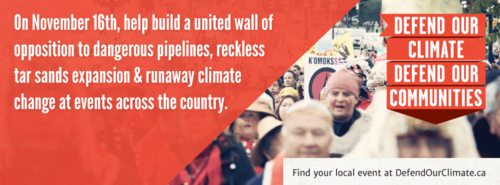
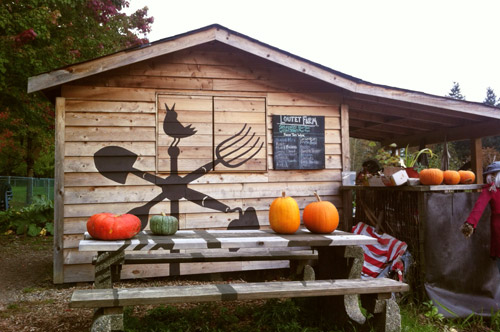
Here in Canada, we’ve already expressed our gratitude and enjoyed family meals together. If you’re south of the border, perhaps you’ll be inspired reading this.
I had the opportunity and pleasure to host and cook Thanksgiving dinner for my parents, at my own place, for the first time. (My sisters and their families stayed in their respective towns.) Naturally, I wanted the meal to be as local and organic as possible, since this is how I live, but it wasn’t until afterward that I thought to write about it.
This is the ultimate time of year to have a hearty, home-cooked meal full of delicious grub grown in your own backyard — literally or figuratively. My parents’ neighbourhood, however, doesn’t have good access to local, organic food, so I took care of all the veggies, procuring them at markets. This meant I missed out on Brussels sprouts, since they’re hard to find locally and a bit expensive. Ten years ago I never would have thought about growing them myself, let alone enjoying them.
Continue reading Where does your Thanksgiving meal come from? »
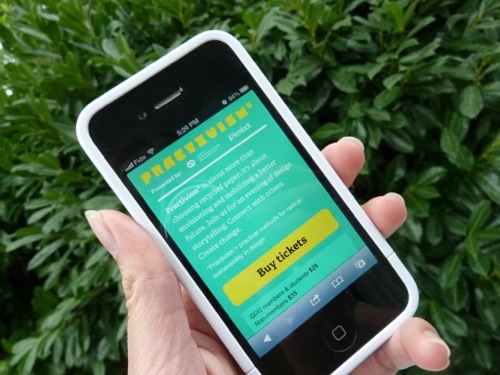
The increasing prevalence of smartphones and tablets has dramatically changed how people access the internet, to the extent that a statistic from last month is out of date today. As a consequence, people — rightly — have the expectation that your website will be easy to read and navigate on their iPhone or Nexus tablet. At best, a website not optimized for an experience on a smaller, touch-based screen will frustrate the visitor but they’ll complete their task (contacting your organization, finding your opening hours, or buying an item for example). At worst, they’ll give up and take their fingers — and business — elsewhere.
Some convincing math on mobile
There are many ways in which having a mobile-friendly website helps your business or organization meet or exceed its goals, not the least of which is making it easier and faster for people to buy your products or complete a petition. But if you’re not convinced there’s a critical mass waiting to look you up on their phone, here’s one juicy fact: an Internet Trends 2013 report shows that 15% of all traffic on the Internet worldwide is now on mobile, and projected to grow 150% per year. That number, of course, may vary for your site; sites I’ve worked on this year are achieving upwards of 20% mobile traffic. If a lot of your traffic comes via email or social media, changes are those numbers are higher.
Continue reading How can responsive retrofitting benefit your business or organization? »
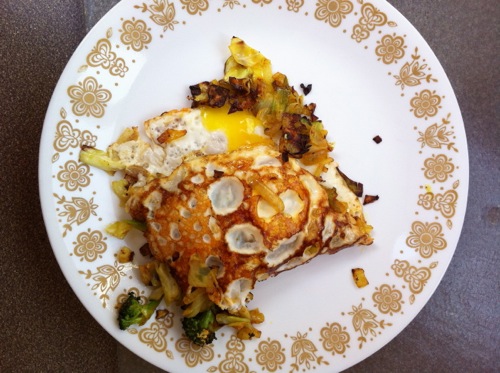
I’ve rediscovered the pleasure of cereal with fresh blueberries eaten in the sunny morning on my balcony. I’ll miss this terribly in the winter, when it will probably be dark and most certainly cold when I eat my breakfast, but one can find joy in it anyway. This poem came out of thinking about dining on my balcony in the fall, which I couldn’t really do last year for lack of outdoor furniture. After October and November wrote themselves, I simply had to keep going.
I realise this is not an ode but I couldn’t come up with a better title, so you’ll have to live with it. It’s inspired by Maurice Sendak’s beloved Chicken Soup with Rice — which taught me the months of the year — and by Molly Wizenberg’s delicious food essays in A Homemade Life, which I’m sad to have finished reading.
I should note while most of these are things I’d eat for breakfast, I should very much like more than a slice of bread and a mandarin orange. That would be a paltry breakfast, indeed.
An Ode to Breakfast
In January’s cupboard forage, a slice of bread and a mandarin orange.
In February’s dim and gloom, leftover soup with a silver spoon.
In March the weather starts to turn; for bacon and fried eggs I’ll yearn.
For April I’d like eggs poached, scrambled, boiled or on some toast.
In May I think I might just try to bake a morning apple pie.
In June I must not forget to make a basil omelet.
In July’s berry dream, a plate of waffles doused in cream.
For all of August, if you please, a bowl of cereal with blueberries.
In September’s temperamental weather, I think yogurt on granola’s better.
In October I shall eat hot pancakes on my balcony.
In November’s rainy weather, a bowl of porridge and a cosy sweater.*
For December’s hopeful snow, maple syrup poured on French toast.
* Eating sweaters is not recommended.
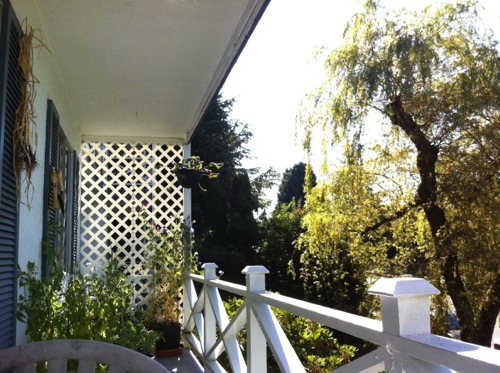
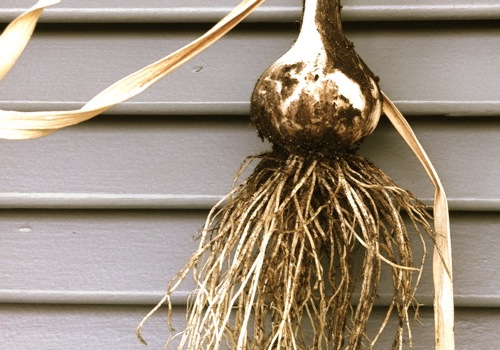
“…we don’t plant too much of any crop, though we are growing dangerously close to having too much garlic. But then how can you ever have too much garlic?”
— Brian Brett, Trauma Farm
I procrastinated a little bit and planted my garlic in November last year. In my kitchen, garlic doesn’t survive very long before being eaten, so it was almost reluctantly that I saved a mere four cloves for planting. They were paired up in pots far too small, I knew, in shallow soil less than ideal but I crossed my fingers and hoped for the best. To my delight, they all came up, and come summer I enjoyed five plump garlic scapes.
Continue reading Patience, hope and garlic »












